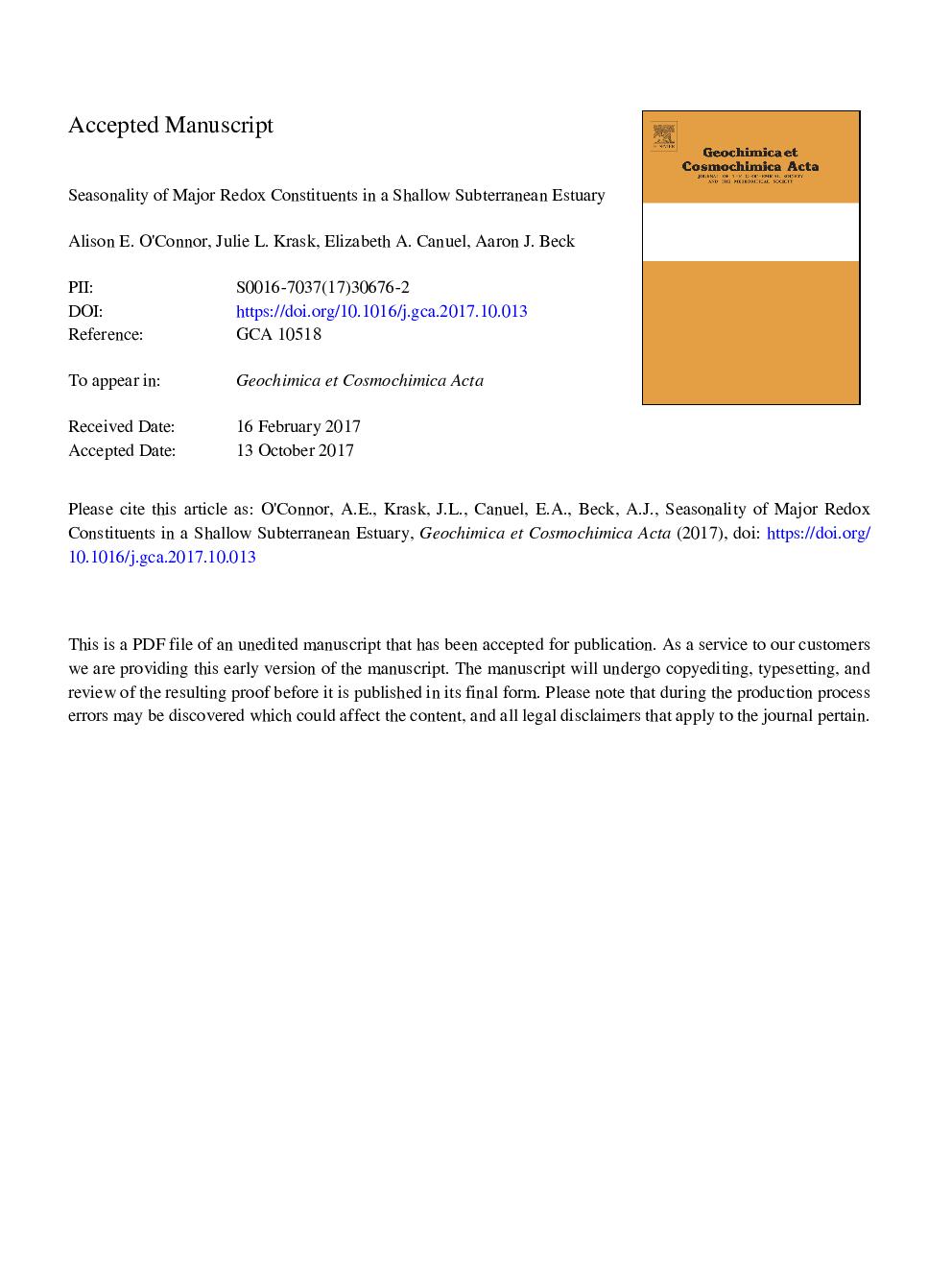| کد مقاله | کد نشریه | سال انتشار | مقاله انگلیسی | نسخه تمام متن |
|---|---|---|---|---|
| 8910887 | 1637933 | 2018 | 48 صفحه PDF | دانلود رایگان |
عنوان انگلیسی مقاله ISI
Seasonality of major redox constituents in a shallow subterranean estuary
ترجمه فارسی عنوان
فصلی بودن اجزای مجتمع اصلی ردوکس در زیرزمین زیرزمینی کم عمق
دانلود مقاله + سفارش ترجمه
دانلود مقاله ISI انگلیسی
رایگان برای ایرانیان
کلمات کلیدی
موضوعات مرتبط
مهندسی و علوم پایه
علوم زمین و سیارات
ژئوشیمی و پترولوژی
چکیده انگلیسی
The subterranean estuary (STE), the subsurface mixing zone of outflowing fresh groundwater and infiltrating seawater, is an area of extensive geochemical reactions that determine the composition of groundwater that flows into coastal environments. This study examined the porewater composition of a shallow STE (<5â¯m depth) in Gloucester Point, VA (USA) over two years to determine seasonal variations in dissolved organic carbon (DOC) and the reduced metabolites Fe, Mn, and sulfide. An additional aim of this study was to investigate the relative importance of salinity gradients (which have great geochemical influence in surface estuaries) versus redox gradients on STE geochemistry. Two freshwater endmembers were identified, between which redox potential and composition varied with depth-a shallow freshwater endmember was oxidizing and high in DOC, whereas a deep freshwater endmember was reducing, lower in DOC, and high in sulfide. Results showed that dissolved Fe, Mn, and sulfide varied along a redox gradient distinct from the salinity gradient, and that three-endmember mixing was required to quantify non-conservative chemical addition/removal in the STE. In addition to salinity, humic carbon was used as a quasi-conservative tracer to quantify mixing according to a three-endmember model. The vertical distributions of DOC and reduced metabolites remained approximately constant over time, but concentrations varied with season. Dissolved organic carbon concentrations were greatest in the summer, and shallow meteoric groundwater supplied the majority of DOC to the STE. In summer, there was additional evidence for shallow non-conservative addition of DOC. Dissolved Fe and Mn were highest in a subsurface plume through the middle of the STE (100-140â¯cm below sediment surface at the high tide line) which was characterized by higher concentrations and greater non-conservative addition in the winter. In contrast, sulfide was higher in summer at depths within the Fe and Mn plume (100-140â¯cm). We attribute the contrasting seasonal patterns of dissolved Fe, Mn, and sulfide to differences in microbial response to temperature changes and organic matter availability, and to competition at the ferrous-sulfidic transition zone between dissimilatory metal reduction and sulfate reduction, leading to sulfate/sulfur reducing bacteria (SRB) being more active in summer and metal reducers being more active in winter. Throughout the STE, seasonal temperature and DOC variations determined the spatial distribution and geochemical cycling of Fe, Mn, and sulfur.
ناشر
Database: Elsevier - ScienceDirect (ساینس دایرکت)
Journal: Geochimica et Cosmochimica Acta - Volume 224, 1 March 2018, Pages 344-361
Journal: Geochimica et Cosmochimica Acta - Volume 224, 1 March 2018, Pages 344-361
نویسندگان
Alison E. O'Connor, Julie L. Krask, Elizabeth A. Canuel, Aaron J. Beck,
